You are probably familiar with deer that have antlers, like the white-tail deer or mule deer. Hunters may brag about getting a 10-point buck, but what does that really mean? Lots of animals have interesting headgear, but do they all have antlers? What about moose? Do moose have antlers or horns? What about the long, wavy, ridged headgear on an Addax? Are those antlers? Reindeer have some of the largest head gear but they look much different than a white-tail deer. Let’s find out all about the types of animals with antlers!

What Are Antlers?

Members of the deer family grow antlers, structures that look vaguely similar to tree branches.
©Mega Pixel/Shutterstock.com
Antlers are tree-branch-looking structures that grow out of the skulls of members of the deer family, Cervidae. Usually, only males grow them (with some exceptions) and antlers fall off every fall, regrowing in the spring (again, with some exceptions). Antlers are made of bone as an extension of the skull and are fed by a blood supply similar to other bones. When the new antlers grow in, they are covered in a velvety material that helps protect them during growth. Antlers are primarily a status symbol used to attract mates like the colorful feathers of a male peacock and the long mane of a dominant male lion. Female reindeer have antlers that they keep throughout the winter and use to brush away snow to find food in the long arctic winters. Most female deer species do not sport antlers.
How Are Antlers Different Than Horns?
Antlers are different than horns because horns are made of keratin and do not shed annually. One general way to think about the difference is that animals in the deer family have antlers and animals in the cow, sheep, and goat family have horns. Examples of animals that have horns are bighorn sheep, water buffalo, American bison, addax, ibex, and Texas longhorn cattle. Let’s take a look at a variety of deer and animals in the deer family that have antlers.
1) White-tail Deer
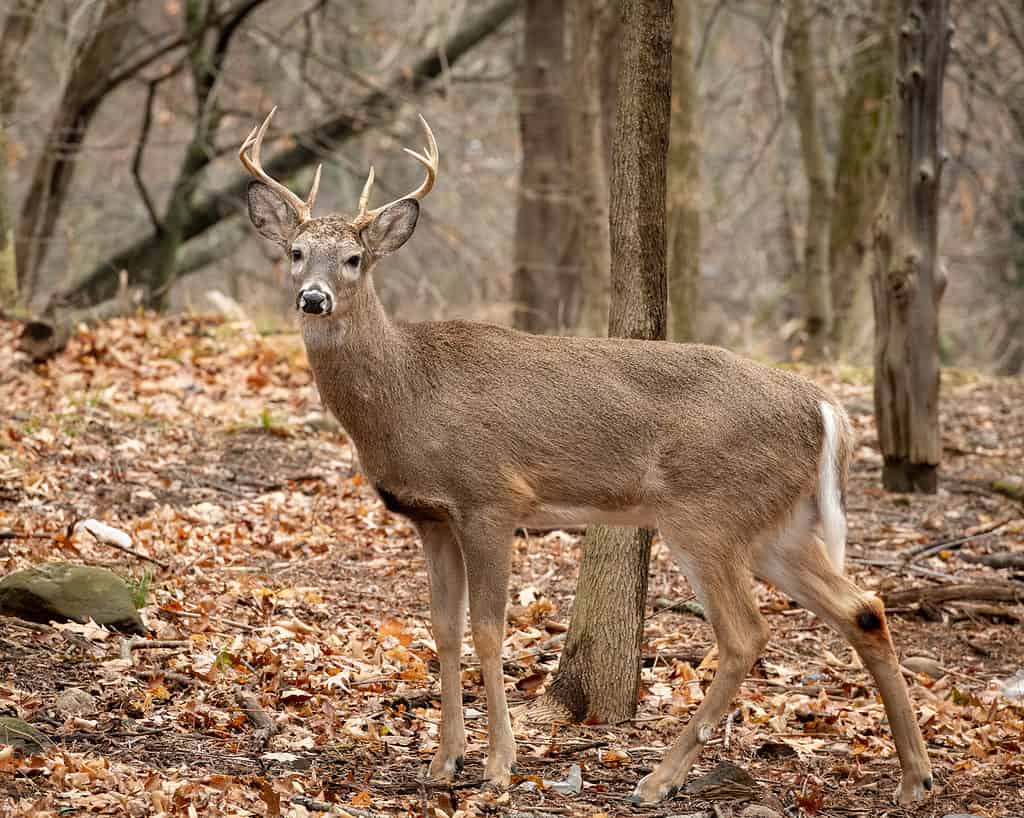
As the most common deer,
white-tail deer
is also one of the most familiar of all that have antlers.
©Herbie Pabst/Shutterstock.com
White-tail deer may be the most familiar animal with antlers in the U.S. The males grow large racks of antlers that can have 8-10 points but 8 points is the most common. That means each set of antlers has 4 branches that come to a point that is more than an inch long. The male deer are called bucks and typically weigh between 150-300 pounds. Female white-tail deer do not grow antlers which makes it easy to tell the two apart but be aware that the males will shed their antlers after the fall rut. Male white-tail deer will shed their antlers in late fall to make it easier to get around during the winter months. Did you know deer antlers can weigh between 3-9 pounds? Nice to take off that load for the winter!
2) Mule Deer
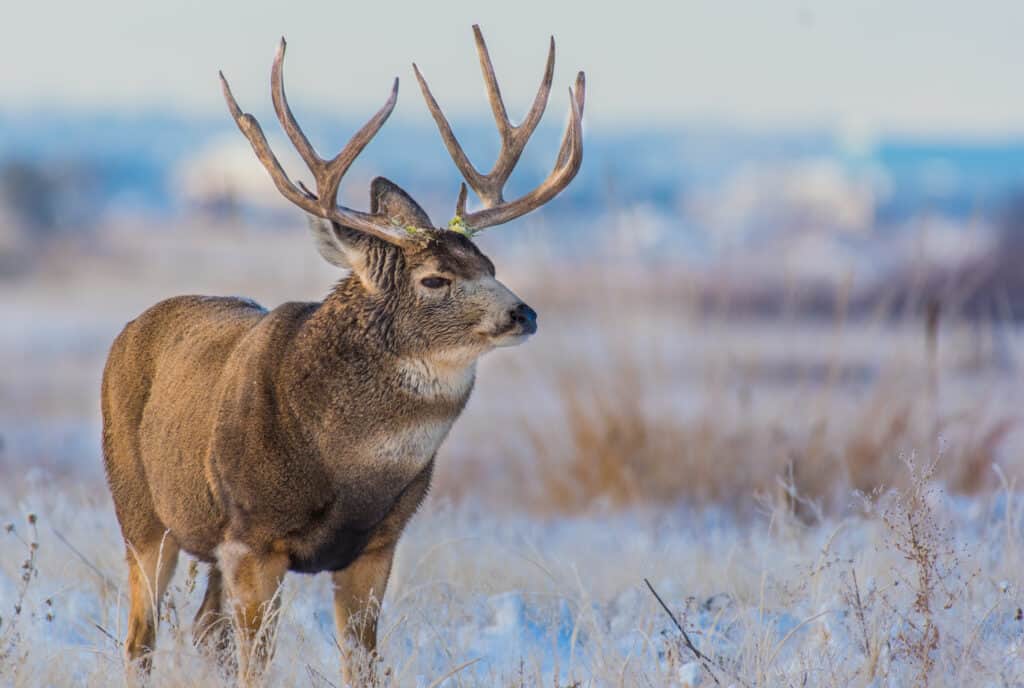
While not as common as white-tail deer, mule deer are still frequent throughout the U.S.
©iStock.com/Kerry Hargrove
The mule deer is another common deer in the U.S. They look quite similar to white-tail deer and their range overlaps in several areas across the country. Mule deer have a slightly darker coloration while white-tail deer are a bit more reddish-tan tinted, but in the summer they have a more similar coloration. Taking a look at their tail ends, mule deer have a white patch on their rear with a white tail and a black tip. White-tail deer have a reddish-tan tail matching their body color with a white underside. When they “flag” their tail upward you can see the white. Mule deer have bigger ears than white tails which is one what to tell the difference between two does that don’t have antlers.
Looking at the antlers you will see that mule deer typically have larger antlers and theirs are “bifurcated”, meaning the points fork off of the main beam. So the antlers fork into two and then two points come off of each of those points. The white-tail deer antlers have four points coming directly off the beam. Sometimes an additional point comes off each side for 10-point bucks.
3) Reindeer

Female reindeer grow antlers just like their male counterparts, unlike other deer species. Further, female reindeer don’t shed their antlers every winter, unlike males.
©Vladimir Melnikov/Shutterstock.com
Reindeer are easily identified by their antlers. You won’t see a reindeer and think, “Hmm, is that a whitetail?” Of course, the obvious giveaway may be where you are when you see these deer because reindeer live in the arctic conditions in Alaska, Canada, Russia, Greenland, Sweden, Norway, and Iceland. Reindeer are actually the same animal as caribou. Caribou in Europe are called reindeer and wild caribou in the U.S. are called caribou, but domesticated caribou in the U.S. are called reindeer.
The antlers on reindeer are huge, and the longest of all deer species. Also, get this: female reindeer also grow antlers! For adult male reindeer, their antlers can measure up to 51 inches. Females are quite a bit smaller but still impressive looking. The antlers of the reindeer have a longer beam that reaches up and forks off above their head with what is called a “bez tine” and back to the side to form a multi-tined branching.
4) Caribou
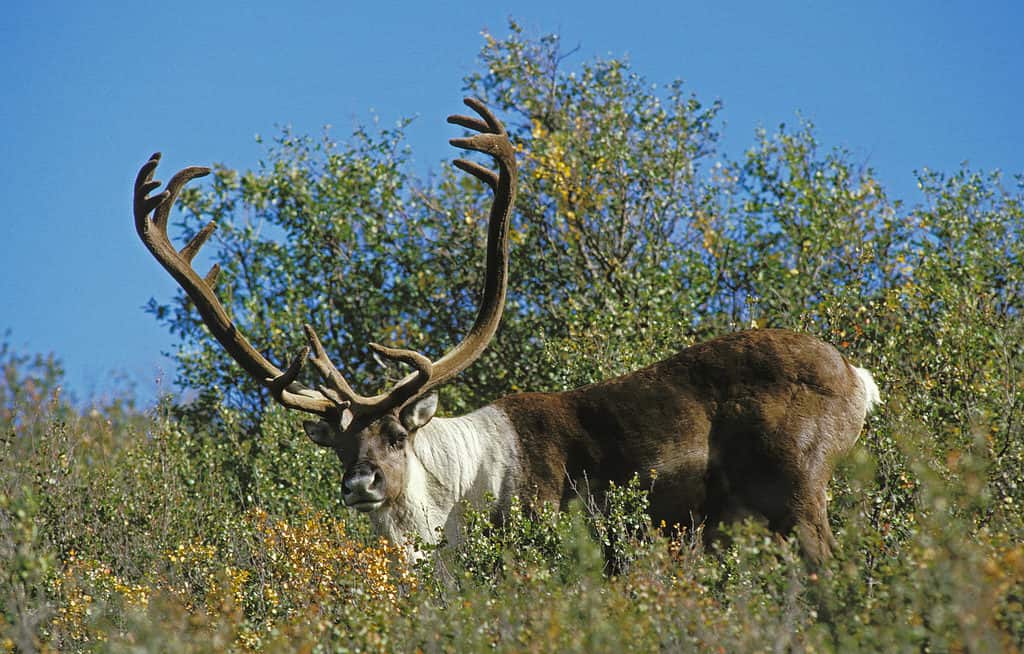
Caribou and reindeer are the exact same animal. Their name is based on location, with wild variants in the United States being caribou, domesticated being reindeer, and all of them in Europe being reindeer.
©iStock.com/slowmotiongli
As we mentioned above, reindeer and caribou are the same animal but are given different names due to location, but let us look at what we commonly call caribou in the U.S. or wild caribou. Caribou used to live in the lower 48 states but recently the last surviving member of the South Selkirk caribou left in the lower 48 was safely transported to a 20-acre reserve in Revelstoke, British Columbia. This population used to spend time in the mountains of Washington and Idaho and migrate back to British Columbia but now are all north of the U.S. border.
Caribou live in Alaska and the northern countries of Canada, Greenland, Russia, Mongolia, Norway, and Finland. Some of these countries refer to them as reindeer. They live in both mountain and forest habitats. Both male and female caribou grow antlers. You can tell the difference between the males and females because the males are generally larger and have larger antlers. Another fun fact is female caribou don’t lose their antlers in the late fall, they keep them until after they give birth to their calves the following spring.
5) Moose
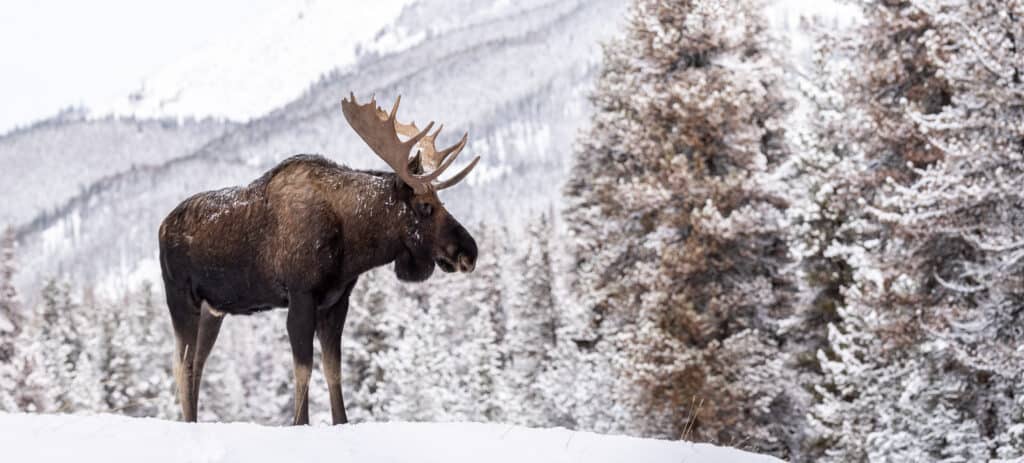
Massive, thick antlers even compared to other deer distinguish moose from other Cervidae family members.
©Harry Collins Photography/Shutterstock.com
Moose are easy to identify with their massive, thick antlers. The antlers fork out from the sides of their heads and branch upward forming what looks like a cupped hand. In fact, the central part of the antlers is called “the palm” and is frequently measured by moose hunters as an important measurement. Can you believe the width of a moose’s antlers can reach six feet wide? The points on the moose’s antlers are more rounded when compared to the points of a white-tail deer.
Besides having massive antlers, moose themselves are massive creatures. Until you see a photo of a person standing by one or experience one in real life it is hard to explain just how big moose can get. Moose can stand 6 feet at the shoulder…that is at the shoulder, not including the head and antlers! They are also hefty animals weighing in at an average of 1,400 pounds. Of course, the males are a little lighter every winter after they shed their giant antlers.
6) Elk
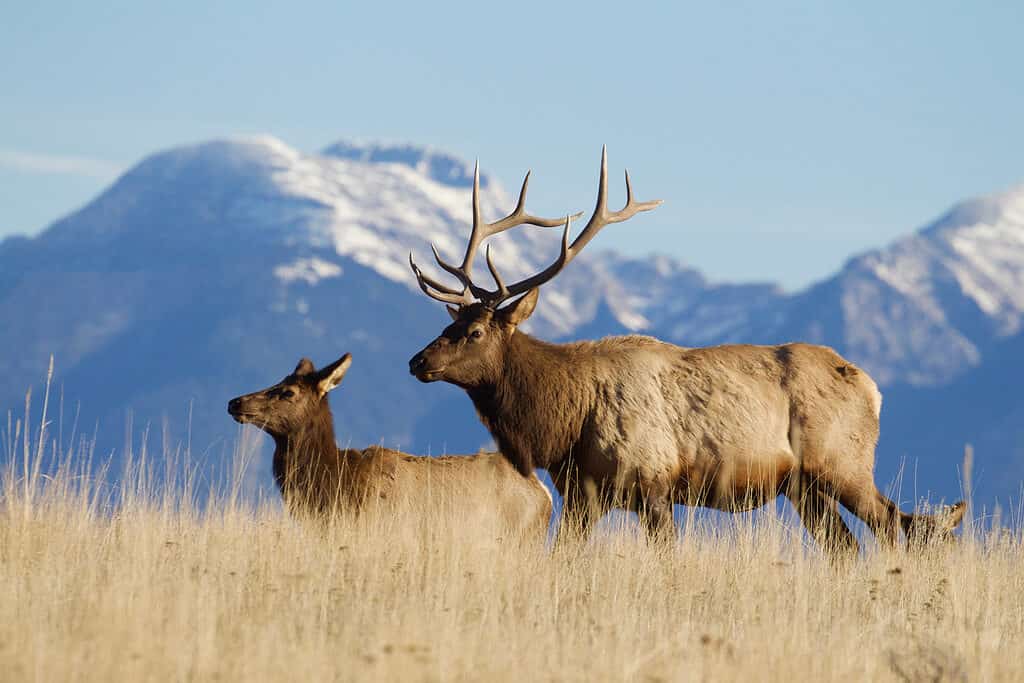
Common to the western side of North America, including Yellowstone National Park, are elk.
©Tom Reichner/Shutterstock.com
Elk can be found in western North America living in some of the forest and mountainous regions. They are common in Yellowstone National Park and the National Elk Refuge in Wyoming. Darker in color and sporting a dark shaggy neckline, you may be surprised how big elk are as well. Not nearly as big as a moose but the adult males can get to be 700 pounds. The males are called “bull elk”. Only the males have antlers.
What are antlers for you might ask? In general, for all the deer family animals, the antlers play a role in mate selection. The health and size of the antlers often display the heartiness of the male and the more attractive mate for passing on its genes. The males also use their antlers to show dominance over other males by sparring and clashing their antlers in a fight. They may fight until one backs down and retreats with the dominant winner standing its ground.
7) Other “Deer”
While we know that animals in the Cervidae family have antlers there are some exceptions and some animals that look like deer, even have “deer” in their name but are not “true deer”. Let’s look at just a couple of the unique ones, including some deer with fangs instead of antlers!
Water Deer
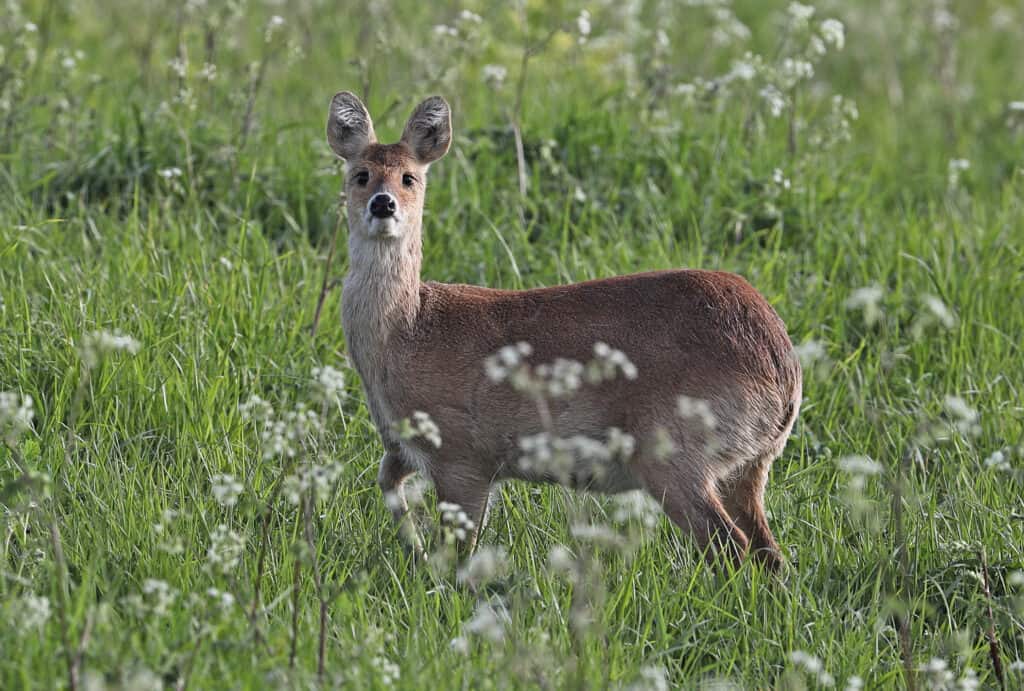
Chinese water deer are notable for their lack of antlers and the presence of fangs.
©iStock.com/Neil Bowman
Water deer or Chinese water deer are a small deer species that live in Asia and are also known as the vampire deer. One look at them and you will understand why! Their canine teeth grow long sharp fangs or tusks that give them the look of a vampire. Water deer only get to be 2 feet tall so nowhere near as large as a white-tail. Chinese water deer are one of the few deer species that do not have antlers.
Musk Deer
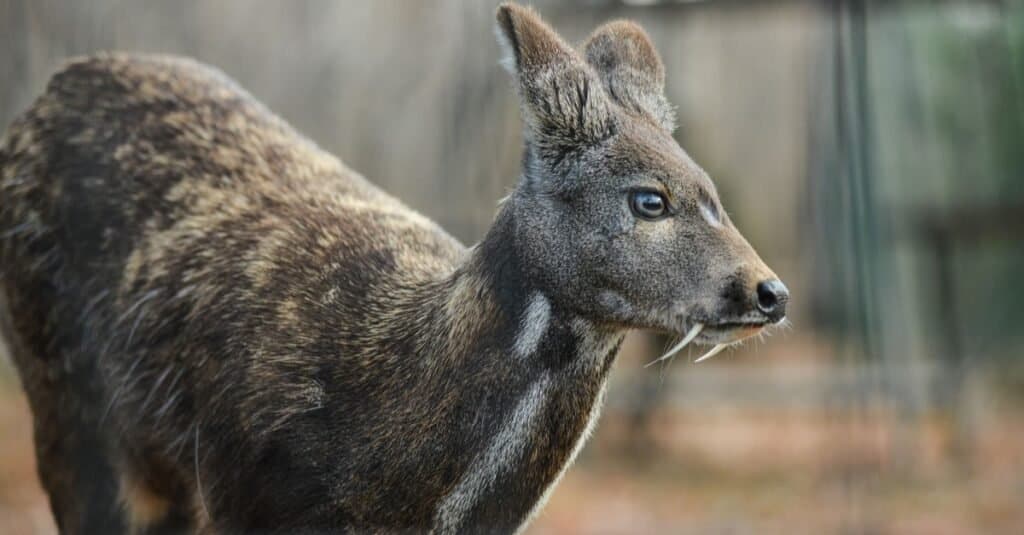
The
Siberian
musk deer, is a rare hoofed animal with fangs.
©Suvorov_Alex/Shutterstock.com
Musk deer also have fangs with their fangs reaching lengths of up to 4 inches, a little longer than water deers. They look very similar to water deer but are not considered “true deer”, they are in the Moschidae family. Musk deer live in central and northeast Asia. One thing that musk deer have that true deer do not is an abdominal musk gland. This musk is used to make perfumes and soaps, may sound familiar now?
Pudu
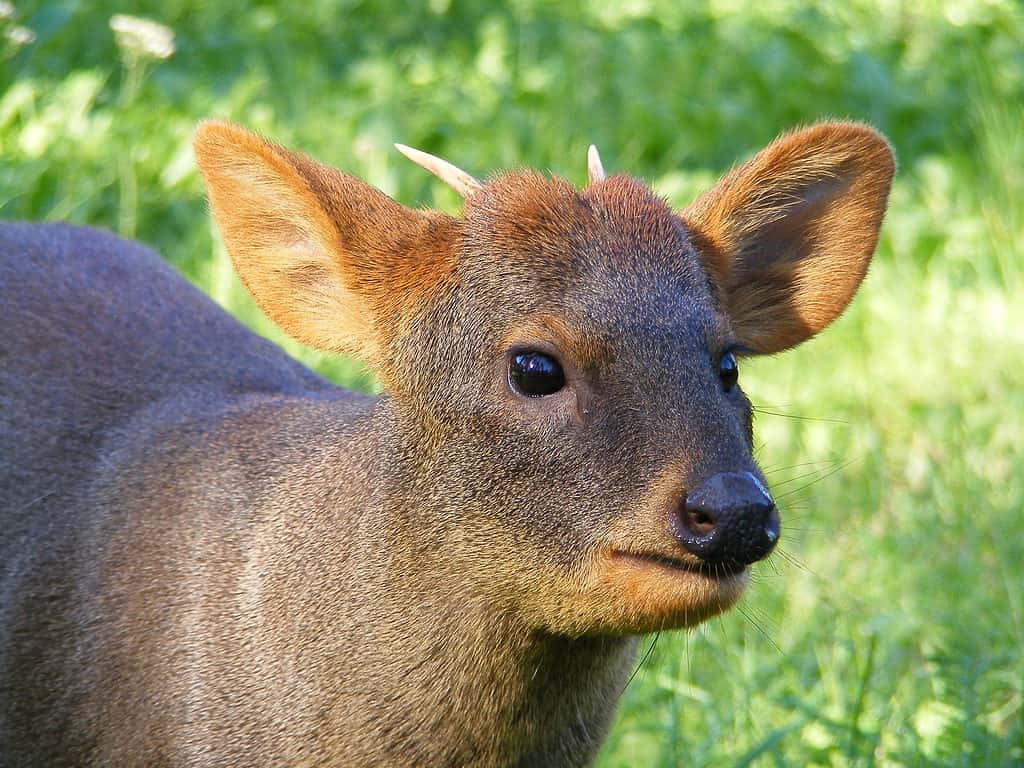
By only reaching about 2 feet tall, the pudu is the smallest true deer species in the world.
©Anastasija Popova/Shutterstock.com
This deer only gets to be 2 feet tall! Pudu is the smallest deer in the world and they are “true deer”. There are 2 kinds of pudu, northern and southern, both living in South America. Pudu only gets to be 14-17 inches tall and are about 30 inches long. So, do pudu have fangs? Antlers? Nothing? Pudu does have antlers but they are really less impressive. Two small thin antlers curve slightly off the top of the male’s heads, ending in a point. The antlers range in size from 2.6-3 inches, which is certainly not something that would be displayed above the fireplace! Pudu are solitary animals and will bark if frightened. It looks like they were made for a peaceful life, so you can’t argue with that.
Mouse Deer
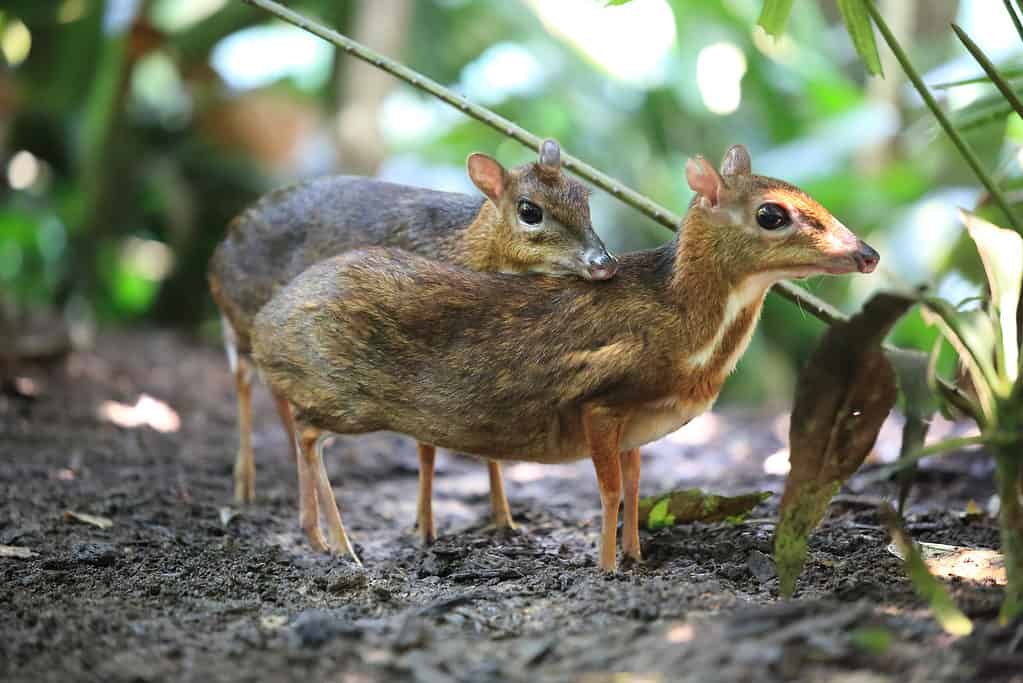
Chevrotains, or mouse deer, are smaller than pudu, but they are not true deer.
©YAMASA/Shutterstock.com
What about mouse deer? They are smaller than pudu so why are pudu considered the smallest deer? Mouse deer, or chevrotains, are not “true deer”, they are in the family Tragulidae. Chevrotains, however, are considered the smallest hoofed animal in the world. These petite deer only reach heights of 12 inches (that’s only a foot!) and weigh between 1 ½ – 17 ¾ pounds. The Java mouse deer is the smallest of all the different mouse deer species. Mouse deer do not have antlers but they do have long canine teeth similar to water deer. Can you imagine a one-foot mouse deer posing next to a six-foot+ moose? The animal world has some amazing creatures!
Summary of 6 Types of Animals with Antlers
| # | Animal | Location |
|---|---|---|
| 1 | White-tail Deer | North America, Central America |
| 2 | Mule Deer | North America |
| 3 | Reindeer | Alaska, Canada, Russia, Greenland, Sweden, Norway, and Iceland |
| 4 | Caribou | Alaska, Canada, Greenland, Russia, Mongolia, Norway, and Finland |
| 5 | Moose | North America |
| 6 | Elk | North America |
Thank you for reading! Have some feedback for us? Contact the AZ Animals editorial team.








